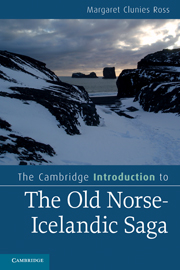Book contents
- Frontmatter
- Contents
- Tables
- A preface on practical issues
- Acknowledgements
- Abbreviations
- Chapter 1 Medieval Iceland
- Chapter 2 What is an Old Norse-Icelandic saga?
- Chapter 3 The genesis of the Icelandic saga
- Chapter 4 Saga chronology
- Chapter 5 Saga subjects and settings
- Chapter 6 Saga mode, style and point of view
- Chapter 7 Saga structures
- Chapter 8 The material record: how we know the sagas
- Chapter 9 Changing understandings of the sagas
- Notes
- Glossary of technical terms
- Guide to further reading
- References to volumes in the Íslenzk fornrit editions of Icelandic sagas
- Index
Chapter 8 - The material record: how we know the sagas
Published online by Cambridge University Press: 05 June 2012
- Frontmatter
- Contents
- Tables
- A preface on practical issues
- Acknowledgements
- Abbreviations
- Chapter 1 Medieval Iceland
- Chapter 2 What is an Old Norse-Icelandic saga?
- Chapter 3 The genesis of the Icelandic saga
- Chapter 4 Saga chronology
- Chapter 5 Saga subjects and settings
- Chapter 6 Saga mode, style and point of view
- Chapter 7 Saga structures
- Chapter 8 The material record: how we know the sagas
- Chapter 9 Changing understandings of the sagas
- Notes
- Glossary of technical terms
- Guide to further reading
- References to volumes in the Íslenzk fornrit editions of Icelandic sagas
- Index
Summary
The material means that enables us, in the twenty-first century, to be able to read and understand medieval Icelandic sagas is unique. It is fundamentally dependent on the hand copying of medieval texts by Icelanders, initially on vellum and then in paper manuscripts, from the Middle Ages until the late nineteenth century. This in its turn is dependent on the Icelanders’ determination to preserve knowledge of their sagas from generation to generation. The history of the preparation of printed editions of saga texts is also important, although it did not gather momentum until the late eighteenth and nineteenth centuries. The way in which the academic study of Old Norse-Icelandic literature developed is also unique but not unrelated to larger intellectual movements within Western society after the Middle Ages, as people sought to understand their own cultural roots and began to prize the earliest written texts that had survived in European languages.
Without some inkling of both these topics, the history of texts and the history of Old Norse literature, a modern reader may fail to understand certain basic issues within saga studies: why many sagas are extant only in post-medieval paper manuscripts when they are assumed to have been composed in the thirteenth or fourteenth centuries; why there are variant versions of saga texts; why so many manuscripts have disappeared or been destroyed; why it is so difficult to date many sagas; how these sagas have been transmitted to modern times; how they were disseminated outside Iceland and outside Scandinavia; what role translations into Latin and various European vernaculars played in the dissemination of these texts; what post-medieval changes in cultural values have led to changes in readerly tastes for certain kinds of sagas over others; what principles have guided editors of the Icelandic sagas when preparing the texts for the use of modern readers.
- Type
- Chapter
- Information
- The Cambridge Introduction to the Old Norse-Icelandic Saga , pp. 140 - 152Publisher: Cambridge University PressPrint publication year: 2010



